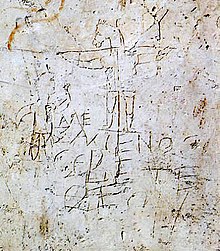
The Alexamenos graffito (also known as the graffito blasfemo, or blasphemous graffito)[1]: 393 is a piece of Roman graffito scratched in plaster on the wall of a room near the Palatine Hill in Rome, Italy, which has now been removed and is in the Palatine Museum.[2] Often called the earliest depiction of Jesus, the graffito is difficult to date, but has been estimated to have been made around the year 200 AD.[3] The image seems to show a young man worshipping a crucified, donkey-headed figure. The Greek inscription approximately translates to "Alexamenos worships [his] god,"[4] indicating that the graffito was apparently meant to mock a Christian named Alexamenos.[5]
- ^ Bayley, Harold (1920). Archaic England: An essay in deciphering prehistory from megalithic monuments, earthworks, customs, coins, place-names, and faerie superstitions. Chapman & Hall. p. 393. Archived from the original on 2015-02-01. Retrieved 2020-02-28.
alexamenos.
- ^ Cite error: The named reference
deckerwas invoked but never defined (see the help page). - ^ "Alexamenos and pagan perceptions of Christians". uchicago.edu.
- ^ Squire, Michael (22 December 2015). Sight and the Ancient Senses. Routledge. ISBN 9781317515388. Retrieved 2018-08-31.
- ^ Viladesau, Richard (1992). The Word in and Out of Season. Paulist Press. p. 46. ISBN 0-8091-3626-0. Retrieved 2016-07-19.